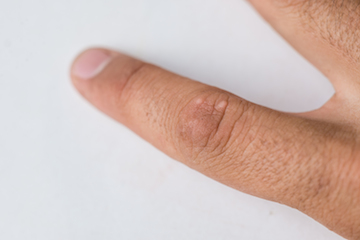This is the most common skin condition in the United States. Acne impacts teenagers and adults alike. A form of acne called Adult Female Acne is becoming more common. Acne starts when a pore gets clogged by dead skin cells. Bacteria trapped inside the pore multiply and this leads to inflammation. Without treatment scars can develop. The majority of acne treatments are topical applications, but in some cases oral medication is needed. In all cases, sticking with a newly recommended treatment regimen is key, as it usually takes 4-8 weeks to see improvement.
This skin condition is characterized by redness and flushing, sometimes with acne like breakouts. It can affect the eyelids as well. In some cases, over time, it causes the skin to develop a thickened bumpy texture. The redness of rosacea can be treated with a topical prescription lotion and with laser treatments. The acne breakouts can be treated with topical lotions and oral medications. Which one is right for you depends on the type of rosacea you have. Rosacea is not cured, but with treatment it can be managed effectively.
Eczema is a condition where the skin is itchy, red, and dry. It occurs in infants, children, and adults. It is more common in individuals with a personal or family history of allergies, hay fever, and asthma. Patients with eczema tend to be sensitive to personal hygiene products with fragrances. It is key to keep the skin well moisturized to prevent eczema flare ups, but sometimes even with excellent motorization, flares will occur. Weather changes, stress, and environmental factors can contribute to flares. The mainstays of treatments are medicated topical creams combined with oral medications when needed. Light therapy is also effective when topical treatments alone are not effective.
Psoriasis is a chronic skin condition that tends to run in families. There are several forms of psoriasis, but it is most common on the elbows, knees, lower back, and sometimes the scalp and nails. The skin in these areas becomes thicker, red, and scaly. It may or may not itch, but sheds flakes. Psoriasis can also affect the joints causing pain, and long term joint damage. There are effective topical and oral medications. Light treatment can also be used. While psoriasis cannot be cured, it can be managed effectively, and some treatments can clear the skin almost completely.
This is a very common skin condition in colder, dryer climates, but it also occurs more commonly as we age. Even here in Florida, where the climate is humid, many patients suffer from dry skin that leads to itching. In the cooler months is when this problem seems to be the worst. To manage dry skin, it is important to moisturize regularly. The best time to do so is right after leaving the shower or bath. I recommend fragrance free moisturizers, as fragrances tend to make dry, irritated skin itchy. If faithful use of a cream moisturizer does not resolve the itching related to dry skin, a topical prescription cream may be needed.
This is a common condition that typically affects the face, scalp, or both. It is caused by a combination of factors including the presence of a yeast that is present on normal and healthy skin, cold weather climate, overall health, and stress. On the scalp, this is commonly referred to as dandruff. While scalp involvement can sometimes be managed effectively with over the counter shampoos, a prescription strength scalp solution and shampoo may be needed. On the face, seborrheic dermatitis appears as redness with flaking between the eyebrows, along the sides of the nose, and in the smile lines. This can be treated with prescription lotions.

Warts are incredibly common in both children and adults. They are caused by a virus (human papilloma virus) that infects the skin and causes it to mound up making the raised spots that we know of as warts. There are many effective over the counter treatments for warts, and they also may resolve on their own. For warts that are persistent despite over the counter treatments, in office treatment with your doctor is recommended. This may include your doctor paring the wart down and freezing it with liquid nitrogen. Laser treatments are also very effective. Warts are contagious, and biting at them can spread them to your lips. Also, if you use a file or abrasive instrument to pare/shave them down, you can spread the virus by using that tool on normal skin.